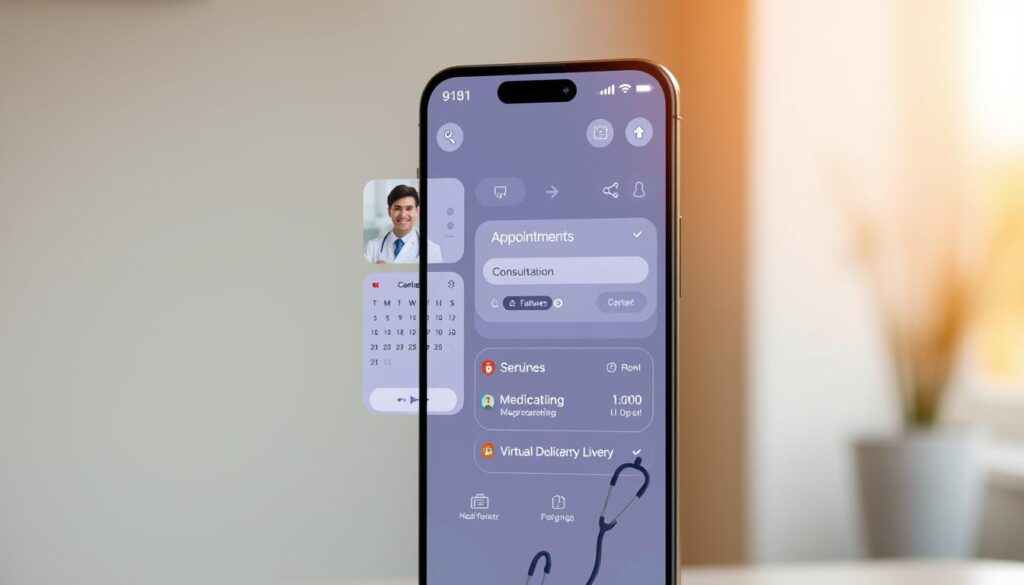
Explore the impact of Generative AI on app interface design and user experience, featuring Meditalk—a healthcare app that utilizes AI for personalized symptom tracking and anxiety relief. Learn how AI-driven innovations are reshaping digital interactions for better accessibility and engagement..
By Mohd Wasil
The digital landscape is undergoing a seismic transformation, driven by the rapid adoption of Generative AI. This technology has revolutionized app interface design, enabling developers and designers to create adaptive, personalized, and intelligent user experiences. One of the most compelling examples of this innovation is Meditalk, a healthcare app designed to alleviate health-related anxiety through AI-powered features such as symptom analysis, conversational interfaces, and interactive 3D models.
In this blog, we will delve into how Generative AI is reshaping app interface design, highlighting its capabilities and exploring why Meditalk stands as a benchmark for AI-driven UI/UX innovation.
Understanding Generative AI
Before diving into its applications in app interface design, it’s essential to understand what Generative AI is. At its core, Generative AI refers to algorithms that can create new content based on the data they have been trained on. This includes text, images, music, and even entire user interfaces. The technology leverages deep learning techniques and neural networks to analyze patterns in existing data and generate new outputs that mimic those patterns.
Key Components of Generative AI
- Machine Learning: This subset of AI focuses on developing algorithms that allow computers to learn from and make predictions based on data.
- Neural Networks: Inspired by the human brain, these systems consist of interconnected nodes (neurons) that process information in layers, enabling complex pattern recognition.
- Natural Language Processing (NLP): This area of AI helps machines understand and generate human language, making it crucial for conversational interfaces and chatbots.
- Computer Vision: This technology enables machines to interpret and understand visual information from the world, which is vital for applications involving image generation or enhancement.
- Reinforcement Learning: A type of machine learning where an agent learns to make decisions by receiving rewards or penalties based on its actions within an environment.
How Generative AI is Revolutionizing App Interface Design
Generative AI is redefining traditional UI/UX design processes by automating repetitive tasks and creating dynamic, outcome-oriented interfaces. Here are key ways this technology is transforming app design:
1. Personalized User Experience
Generative AI enables apps to adapt interfaces to individual user preferences, behaviors, and needs in real time.
- Dynamic Content Adjustments: Fonts, color schemes, and layout elements change based on user engagement patterns. For example, users with dyslexia may see text rendered in dyslexia-friendly fonts and high-contrast colors.
- Adaptive Navigation: Menus and controls are optimized based on past interactions, offering shortcuts tailored to user habits. For instance, if a user frequently accesses a specific feature, it can be highlighted or moved to a more accessible location.
- Smart Widgets: Features such as symptom tracking in healthcare apps are suggested dynamically based on user behavior. If a user regularly logs certain symptoms, the app can proactively remind them to do so or provide relevant resources.
2. Intelligent User Input Handling
Generative AI simplifies data input methods, making interactions intuitive and efficient.
- Conversational Interfaces: AI-powered chatbots replace static forms, allowing users to input data using natural language. This not only enhances usability but also makes the experience more engaging.
- Voice and Gesture Recognition: Hands-free interaction options improve accessibility for users with physical disabilities. Users can navigate through voice commands or gestures instead of relying solely on touch.
- Interactive 3D Models: Apps like Meditalk utilize 3D body models for precise symptom logging. Users can visually indicate pain locations or symptoms by interacting with a 3D representation of the human body.
3. Accessibility & Inclusivity Enhancements
AI-driven interfaces ensure seamless experiences for all users, including those with disabilities.
- Screen Readers: AI-powered screen readers enhance navigation for visually impaired users by converting text into speech or braille output.
- Text Adjustments: Real-time font and layout changes accommodate users with dyslexia or cognitive impairments by adjusting text spacing or using simpler language.
- Multilingual Support: Generative AI interfaces break language barriers by offering translations in real time. This feature ensures that non-native speakers can access information without confusion.
4. Automated UI/UX Design Optimization
Generative AI accelerates the design process by auto-generating UI elements based on best practices.
- AI-Generated Wireframes: Tools like Uizard transform hand-drawn sketches into digital designs within seconds. Designers can iterate quickly without starting from scratch each time.
- Automated A/B Testing: Real-time feedback enables continuous UI improvements by allowing developers to test multiple versions of an interface simultaneously.
- Predictive Design Enhancements: AI suggests modifications to boost engagement metrics based on analytics. For example, if users frequently abandon a particular screen, the system may recommend layout changes or additional prompts to retain their attention.
Meditalk: A Case Study in AI-Powered UI/UX
Meditalk exemplifies the transformative potential of Generative AI in healthcare app design. Its features showcase how intelligent interfaces can enhance user experience while addressing complex health concerns.
1. Precise Pain Localization with 3D Visualization
One standout feature of Meditalk is its ability to allow users to pinpoint pain areas on a 3D human body model. This feature not only simplifies symptom reporting but also makes it more visual and precise. Users can rotate and zoom into different body parts to indicate where they feel discomfort or pain.
This visual approach eliminates ambiguity often associated with traditional symptom checklists where users might struggle to articulate their feelings accurately. By providing a clear visual reference, Meditalk enhances communication between users and healthcare providers while ensuring that users feel understood.
2. Conversational Symptom Logging
Instead of filling out tedious forms that require manual input of symptoms and conditions, users engage with an intelligent chatbot that dynamically adjusts its questions based on previous responses. For instance:
- If a user reports headaches one day, the chatbot might follow up with questions about potential triggers (e.g., stress levels or dietary changes) during subsequent interactions.
- The chatbot can also ask clarifying questions if it detects inconsistencies in reported symptoms over time—helping users refine their self-reports for better accuracy.
This conversational approach reduces friction in symptom reporting while making it feel less clinical and more like an engaging dialogue.
3. AI-Powered Symptom Analysis
Meditalk’s advanced algorithms analyze symptom patterns over time to provide initial insights into potential health issues. By recognizing trends—such as recurring symptoms or sudden changes—the app can alert users when they may need professional consultation.
For example:
- If a user frequently logs anxiety-related symptoms alongside physical complaints like chest pain or shortness of breath, Meditalk can suggest seeking immediate medical advice.
- Additionally, the app may offer educational content related to identified symptoms—empowering users with knowledge about their health conditions without overwhelming them with medical jargon.
This proactive approach not only enhances user engagement but also fosters informed decision-making regarding health management.
4. Human-AI Support for Anxiety Relief
Health-related anxiety can be overwhelming for many individuals; Meditalk addresses this challenge through its Human-AI assistant feature. This assistant offers calming advice tailored specifically to each user’s needs based on their reported anxiety levels and triggers.
For instance:
- If a user expresses heightened anxiety due to recent health concerns or symptoms logged within the app, the assistant might guide them through mindfulness exercises or breathing techniques designed to alleviate stress.
- The assistant could also provide resources such as articles about coping strategies for anxiety or links to support groups—creating a holistic approach to mental well-being alongside physical health management.
The Future of AI-Driven UI/UX
As we look ahead at the future landscape shaped by Generative AI technologies like those seen in Meditalk’s design philosophy, several trends emerge:
1. Hyper-Personalization
We will witness hyper-personalized interfaces adapting dynamically in real-time according to individual user behaviors—creating truly unique experiences tailored specifically for each person’s preferences and needs.
Imagine an app that learns your daily routines over time: it adjusts notifications based on when you typically check your phone; it suggests features you’re likely interested in at any given moment; it even curates content relevant not just broadly but specifically tailored around your interests!
2. Accelerated Design Processes
The use of generative design templates will reduce manual work significantly while maintaining high fidelity across devices—allowing designers more time for creative exploration rather than repetitive tasks involved in creating standard layouts from scratch every single time they start anew!
With tools powered by generative algorithms able to produce multiple variations instantly based upon given parameters (like color schemes), designers could experiment freely without fear of wasting hours iterating over minor details—leading ultimately toward faster iterations overall!
3. Natural Interactions
Conversational UIs powered by voice recognition will make interactions feel more human-like—allowing users greater freedom when navigating applications using natural speech patterns rather than rigid commands alone!
This evolution opens doors towards seamless integration between digital environments & everyday life; imagine asking your phone questions about health concerns while cooking dinner instead of having to pause everything just so you can type out queries manually!
4. Predictive Enhancements
Apps will continuously optimize usability based on advanced analytics combined with machine learning capabilities—allowing them not only respond reactively but proactively anticipate what users might want next based upon historical behavior patterns observed across various contexts!
For instance: if someone frequently accesses specific features during certain times throughout their week (like tracking workouts every Monday morning), predictive algorithms could automatically surface those options first thing Monday morning without needing any prompting whatsoever!
Challenges Facing Generative AI in UI/UX Design
While the potential benefits are immense when integrating generative technologies within application development processes; several challenges remain prevalent today:
- Ethical Considerations: As we harness powerful algorithms capable of influencing decisions made by individuals regarding their health & well-being; ensuring ethical standards remain paramount becomes critical! Developers must prioritize transparency around how data gets collected/stored/used while maintaining user privacy at all times!
- Bias in Algorithms: Machine learning models trained on biased datasets risk perpetuating existing inequalities within society! Developers must actively work towards identifying biases present within training data sets used during development phases—ensuring fair representation across diverse demographics throughout all stages involved!
- User Trust: Building trust among end-users remains vital for successful adoption rates! Users need assurance regarding accuracy levels associated with generated insights before fully relying upon them when making important decisions about their lives! Clear communication around limitations inherent within these technologies will help foster confidence moving forward!
- Technical Limitations: Despite rapid advancements made recently within fields related directly back toward generative technologies; limitations still exist regarding computational power required for processing complex tasks effectively! Developers must continue investing resources into optimizing performance capabilities while minimizing latency issues experienced during real-time interactions!
Conclusion
Generative AI is reshaping how we design and interact with digital applications across various industries—from healthcare solutions like Meditalk aimed at alleviating anxiety through innovative interfaces—to e-commerce platforms enhancing shopping experiences via personalized recommendations tailored specifically toward individual preferences!
As we continue exploring possibilities presented through this transformative technology; one thing remains clear: embracing generative approaches allows us not only create better products but also foster deeper connections between users & their digital environments ultimately leading toward improved overall satisfaction levels experienced throughout journeys taken together!
What are your thoughts on the role of Generative AI in UI/UX design? Let’s discuss in the comments below!
#AI #UIUX #GenerativeAI #HealthcareTech #Meditalk #UXDesign #ArtificialIntelligence #MobileApps





